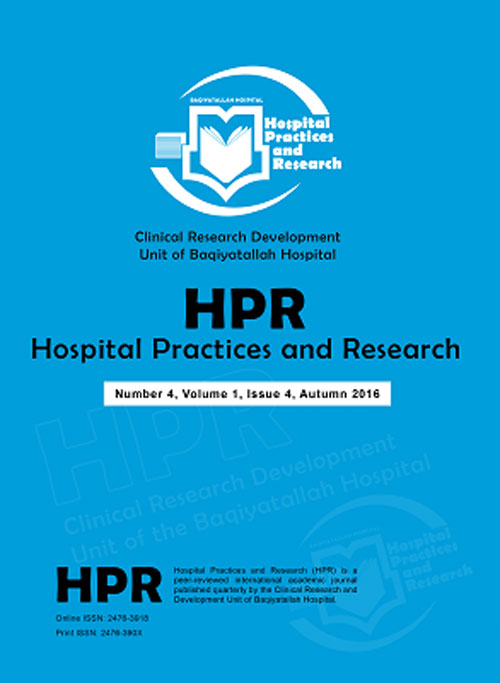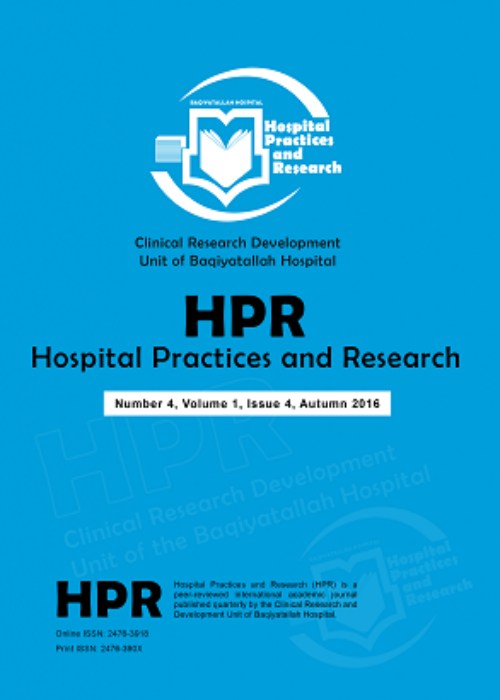فهرست مطالب

Hospital Practices and Research
Volume:1 Issue: 2, Spring 2016
- تاریخ انتشار: 1395/02/28
- تعداد عناوین: 9
-
Pages 39-41Accessibility to all levels of information technology has experienced rapid progress in recent years, particularly in the health sector. Rapid penetration into this technology has led to changes in lifestyles and changes in the working procedures of institutions. In 2014, the number of Internet users reached 3 billion, and this number is predicted to exceed 8 billion in 2018. Statistics estimate the number of Iranian users of the Internet to be about 45 million. In 2014, more than 80% of Internet users searched for health information. Today, the Internet plays a vital role in providing such health services as education, disease management, support, basic medical treatment decisions, and doctor-patient communication.Keywords: E, Health, patients, Society, Physicians
-
Pages 43-46BackgroundIntravenous catheterization is a routine technique in medical centers which can cause diverse problems such as thrombophlebitis.ObjectiveThis study aimed to resolve replacement scheduling and proper cannula diameter and position issues for intravenous catheters.MethodsIn this 2015 experimental cohort study, 232 hospitalized patients receiving medication intravenously were assessed for the occurrence of thrombophlebitis (TF). Involved TF factors such as age, gender, cannula size, site of cannula in hand veins, duration of usage, and underlying disease were evaluated in patient and healthy control groups.ResultsTF developed in 55 of 232 patients. The percentages of incidence were similar in men and women (30%). The patient mean age was lower than that of the control, but the difference was not significant. Average weight was significantly higher in the patient group than in the control group. The average duration of cannula in situ was significantly lower in patients than in the control group. The highest rate of TF occurred in the narrowest cannula usage and dorsal hand vein positions. The mean time of developing TF was lower than that indicated in CDC guidelines. Furthermore, 24 patients with TF (34%) had diabetes mellitus.ConclusionIn the current study, the percentage of TF occurrence was higher in patients with weight increase, use of narrower cannulae, dorsal hand vein positions, and a history of diabetes. Furthermore, TF can develop within 72 hours. It was concluded that some patients may be more susceptible to TF and require more care. Accordingly, the CDC guidelines offered scheduling for intravenous catheter replacement is not trustworthy.Keywords: Thrombophlebitis, Cannula, risk factors, patients, Hospitals
-
Pages 47-52BackgroundMotivation is a driver to health worker performance in most Ghanaian hospitals. In view of this, Ghanas Ministry of Health has rolled out enough motivational policies to accentuate work performance of health workers.ObjectiveThe focus of this study was to examine the impact of motivation and identify how intrinsic and extrinsic motivating factors affect the work performance of health workers at Korle-Bu Teaching Hospital (KBTH).MethodsA qualitative approach was adopted for the study, and purposive sampling was used to select fifteen (15) health workers including both medics and paramedics. An in-depth interview guide and one-on-one interviews were adopted to collect data from the staff at Korle Bu Teaching Hospital. A thematic content analysis was used to analyze the transcribed data.ResultsKey findings from the study revealed that job satisfaction, logistic provision, and an enabling work environment are intrinsic motivating factors that affect the work performance of health workers; extrinsic factors such as financial reward, accommodation, and transportation also impact work performance. Furthermore, motivation is key to the work performance of nurses.ConclusionIt is recommended that the National Midwifery and Nursing Council (NMC) and the Ministry of Health (MOH) adopt motivational policies based on the intrinsic and extrinsic motivational blocks.Keywords: Motivation, Performance, Intrinsic, Extrinsic
-
Pages 53-58BackgroundLength of stay is one of the most important indicators in assessing hospital performance. A shorter stay can reduce the costs per discharge and shift care from inpatient to less expensive post-acute settings. It can lead to a greater readmission rate, better resource management, and more efficient services.ObjectiveThis study aimed to identify the factors influencing length of hospital stay and predict length of stay in the general surgery department.MethodsIn this study, patient information was collected from 327 records in the surgery department of Shariati Hospital using data mining techniques to determine factors influencing length of stay and to predict length of stay using three algorithms, namely decision tree, Naïve Bayes, and k-nearest neighbor algorithms. The data was split into a training data set and a test data set, and a model was built for the training data. A confusion matrix was obtained to calculate accuracy.ResultsFour factors presented: surgery type (hemorrhoid), average number of visits per day, number of trials, and number of days of hospitalization before surgery; the most important of these factors was length of stay. The overall accuracy of the decision tree was 88.9% for the training data set.ConclusionsThis study determined that all three algorithms can predict length of stay, but the decision tree performs the best.Keywords: Data mining, Decision tree, General Surgery, Length of Stay
-
Pages 59-62BackgroundPerson-organization fit is an effective factor for recruiting, selection, and retention of human resources in organizations.ObjectiveThis study examined the correlation between person-organization fit and performance indicators used in healthcare in the hospitals affiliated with Qazvin University of Medical Sciences (QUMS).MethodsThis descriptive cross-sectional study was conducted in 2014. A total of 324 employees were randomly selected from among the study population comprising the staff of teaching hospitals affiliated with QUMS. The sample size was distributed between the hospitals using the class-ratio method. Data were collected using person-organization fit (Scroggins) questionnaires, and their validity and reliability were evaluated. Data analysis was done using Spearman-Pearson correlation, chi-square, and Kruskal-Wallis tests.ResultsIn terms of values fit, personality fit, and skills, knowledge, and ability fit, hospital C ranked first among the hospitals tested with average ratings of 175.99, 195.53, 199.49, respectively. Significant relationships were found between person-organization fit and patients admitted per bed, median duration of patient stay, and crude mortality rate. No significant relationships were found between person-organization fit and the performance indicators of bed circulation and bed occupancy rate (p ≤ 0.05).ConclusionIn order to show an association between person-organization fit and the performance indicators, more efficient use of resources and improved efficiency is suggested. Policymakers must pay more attention to person-organization fit during recruitment, selection, and assignment of staff.Keywords: Person-Organization Fit, Performance Indicators, Hospitals
-
Pages 63-65BackgroundNowadays, quality of patient care is one of the major and important concerns of health care delivery which is extremely dependent on the medical staff.ObjectivesThe purpose of this study was to investigate the relationship between Quality of Work Life (QWL) and quality of patient care.MethodsThis study was a descriptive-analytic study based on correlation which was conducted in the educational hospitals of Kermanshah. A total of 320 medical staffs were selected for the study. Quality of Work Life and Quality of Patient Care questionnaires were used to collect the data. For data analysis, descriptive statistics, person correlation coefficient, t-test and multivariate regression were used by using SPSS16ResultsData analysis showed that the Quality of Work Life of medical staffs was in a medium level. Our findings indicate that there is a significant, negative relationship between stress at work and quality of patient care (P-value=0.001 & r=-0.247) and there is a significant, positive relationship between control & job satisfaction and quality of patient care (P-value=0.001 & r=0.217). Results of multivariate regression analysis showed that stress at work net account for 6% of the variance of the quality of patient care.ConclusionFocusing on improving the working conditions of medical staffs can be incredibly useful in increasing the quality of health care.Keywords: Quality of Health Care, Stress, Medical Staff
-
Pages 67-71BackgroundPatient safety is a serious global public health issue. Estimates show that every day many patients are harmed while receiving hospital care. Health care staff plays a key role in providing quality and safe patient care, especially physicians who are main members of the medical team and a critical element in patient safety efforts.ObjectiveThe current study used a Theory of Planned Behavior (TPB) framework to investigate predictors of patient safety intentions and behavior of physicians.MethodsThis descriptive analytical study was conducted in 8 hospitals with 52 physicians participating. A researcher-designed questionnaire was prepared to investigate patient safety behaviors and behavior constructs of physicians based on the guidelines of constructing a TPB Questionnaire: Conceptual and Methodological Considerations. The content validity and reliability of the questionnaire were confirmed. Binary logistic regression analysis was performed using SPSS18.ResultsThe total mean score of physician safety behavior indicated that 3.8±0.92. 42% of physicians reported their safety behavior at a good level. There was no significant difference between the patient safety function of physicians in public and private hospitals (P=0.8) and working in medical or surgical wards (P=0.4). Among TPB constructs, normative beliefs had the greatest influence on physician intention for safety behaviors (wald=3.828, P=0.05).ConclusionThe results showed that normative beliefs had the greatest influence on physician intention for safety behaviors; therefore, it seems that patient safety must be the most important concern of all health care staff, specifically managers and executives throughout health care centers.Keywords: Patient safety, Physicians, behavior, Hospitals
-
Pages 73-75IntroductionHomeopathy can be applied to treat various diseases and conditions such as cancer, allergy, mood disorders, headache and pain. This case showed that homeopathic medicine can be a treatment modality for idiopathic thrombocytopenic purpura (ITP), an autoimmune-mediated hematologic disorder.Case PresentationThe patient was a 5.5year-old child with ITP who referred to the homeopathic clinic with extensive petechiae and purpura on her body. Her platelet count was 15000/mcL and her anti-dsDNA and ANA were negative on her first visit. Her disease had first been diagnosed at the age of 2.5 years. She had undergone routine therapy for ITP; however, despite 15 months of corticosteroid therapy and IVIG injections, her platelet count was still low. After treatment with homeopathic remedies, her platelet count increased and signs of ITP disappeared.ConclusionHomeopathic remedies can be considered as complementary and alternative medicines for ITP treatment protocols.Keywords: Homeopathy, Idiopathic Thrombocytopenic Purpura, Thrombopoietin Receptor, Hematologic Diseases


